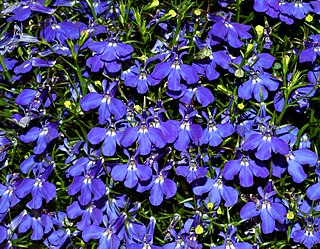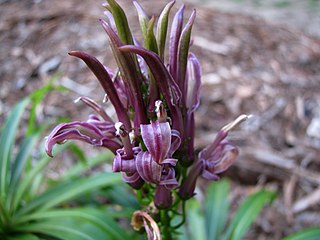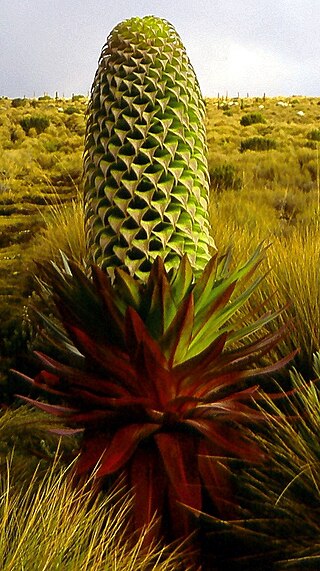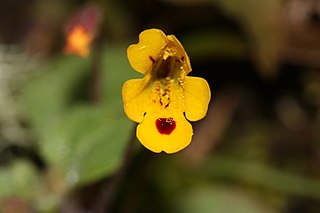
Lobelia is a genus of flowering plants comprising 415 species, with a subcosmopolitan distribution primarily in tropical to warm temperate regions of the world, a few species extending into cooler temperate regions. They are known generally as lobelias.

The family Campanulaceae, of the order Asterales, contains nearly 2400 species in 84 genera of herbaceous plants, shrubs, and rarely small trees, often with milky sap. Among them are several familiar garden plants belonging to the genera Campanula (bellflower), Lobelia, and Platycodon (balloonflower). Campanula rapunculus and Codonopsis lanceolata are eaten as vegetables. Lobelia inflata, L. siphilitica and L. tupa and others have been used as medicinal plants. Campanula rapunculoides may be a troublesome weed, particularly in gardens, while Legousia spp. may occur in arable fields.

Epilobium is a genus of flowering plants in the family Onagraceae, containing about 197 species. The genus has a worldwide distribution. It is most prevalent in the subarctic, temperate and subantarctic regions, whereas in the subtropics and tropics Epilobium species are restricted to the cool montane biomes, such as the New Guinea Highlands.

The Hawaiian lobelioids are a group of flowering plants in the bellflower family, Campanulaceae, subfamily Lobelioideae, all of which are endemic to the Hawaiian Islands. This is the largest plant radiation in the Hawaiian Islands, and indeed the largest on any island archipelago, with over 125 species. The six genera involved can be broadly separated based on growth habit: Clermontia are typically branched shrubs or small trees, up to 7 metres (23 ft) tall, with fleshy fruits; Cyanea and Delissea are typically unbranched or branching only at the base, with a cluster of relatively broad leaves at the apex and fleshy fruits; Lobelia and Trematolobelia have long thin leaves down a single, non-woody stem and capsular fruits with wind-dispersed seeds; and the peculiar Brighamia have a short, thick stem with a dense cluster of broad leaves, elongate white flowers, and capsular fruits. The relationships among the genera and sections remains unsettled as of April 2022.

Lobelia cardinalis, the cardinal flower, is a species of flowering plant in the bellflower family Campanulaceae native to the Americas, from southeastern Canada south through the eastern and southwestern United States, Mexico and Central America to northern Colombia.

Stylidium alsinoides is a dicotyledonous plant that belongs to the genus Stylidium. It is an erect annual plant that grows from 18 to 30 cm tall. Obovate or elliptical leaves, about 20–100 per plant, are scattered along the elongate, glabrous stems. The leaves are generally 5.5–14 mm (0.22–0.55 in) long and 3–8 mm (0.12–0.31 in) wide. The bracts on the inflorescence can be as large as leaves and may be hard to distinguish them except for their growth habit: the leaves are alternate whereas the bracts are opposite.

Lobelia erinus is a species of flowering plant in the bellflower family Campanulaceae, native to southern Africa.

Lobelia deckenii is a species of flowering plant in the family Campanulaceae. It is a giant lobelia endemic to the mountains of Tanzania. It is listed as a threatened plant of the forests of Cherangani hills, Kenya. It grows in moist areas, such as valley bottoms and moorland, in contrast to Lobelia telekii which grows in a similar but drier habitat. These two species produce occasional hybrids. Lobelia deckenii plants usually produce multiple rosettes. Each rosette grows for several decades, produces a single large inflorescence and hundreds of thousands of seeds, then dies. Because individual plants have multiple rosettes, they survive to reproduce repeatedly, and plants with more rosettes flower more frequently. It is iteroparous.

Andersonia is a subgenus of Stylidium that is characterized by a linear hypanthium, recurved mature capsule walls, an erect and persistent septum, and many seeds. This subgenus occurs in areas of tropical northern Australia and into Southeast Asia and was named in honour of William Anderson, the surgeon and naturalist who sailed with James Cook.

Stylidium section Alsinoida is a taxonomic rank under Stylidium subgenus Andersonia. In his 1908 monograph on the family Stylidiaceae, Johannes Mildbraed had established the subgenus Alsinoides for species related to S. alsinoides, which were morphologically similar to species of subgenus Andersonia. In 2000, A.R. Bean published a taxonomic revision of subgenus Andersonia and reduced subgenus Alsinoides to sectional rank, renamed Alsinoida.

Lobelia dortmanna, Dortmann's cardinalflower or water lobelia, is a species of flowering plant in the bellflower family Campanulaceae. This stoloniferous herbaceous perennial aquatic plant with basal leaf-rosettes and flower stalks grows to 0.7–2 m (2.3–6.6 ft) tall. The flowers are 1–2 cm long, with a five-lobed white to pale pink or pale blue corolla, produced in groups of one to ten on an erect raceme held above the water surface. The fruit is a capsule 5–10 mm long and 3–5 mm wide, containing numerous small seeds.

Lobelia inflata, also known as Indian tobacco or puke weed, is a species of Lobelia native to eastern North America, from southeastern Canada south through the eastern United States to Alabama and west to Kansas.

Lobelia siphilitica, the great blue lobelia, great lobelia, or blue cardinal flower, is a plant species within the family Campanulaceae. It is an herbaceous perennial dicot native to eastern and central Canada and United States. There are two recognized varieties of Lobelia siphilitica, Var. siphilitica and Var. ludoviciana. Blooming from August to October, it is short-lived, lasting only for a few years.
Pratia is a formerly recognized genus of flowering plants in the family Campanulaceae, native to Asia, Australia and New Zealand. Along with other genera, such as Hypsela and Isotoma, it is now included in Lobelia.

Lobelia kalmii is a species of flowering plant with a distribution primarily across Canada and the northern United States in temperate and boreal regions. It was formerly known as Lobelia strictiflora (Rydb.) It is commonly known as Kalm's lobelia, Ontario lobelia and Brook lobelia.

Erythranthe alsinoides is a species of monkeyflower known by the common names wingstem monkeyflower and chickweed monkeyflower. It was formerly known as Mimulus alsinoides.
Pentachaeta alsinoides, the tiny pygmydaisy, is a species of flowering plant in the family Asteraceae endemic to California. It is an annual, low, slender, diffuse, somewhat villous; leaves filiform or nearly so; disk flowers reddish, ray flowers inconspicuous.

Evolvulus alsinoides, commonly known as dwarf morning-glory and slender dwarf morning-glory, is flowering plant from the family Convolvulaceae. It has a natural pantropical distribution encompassing tropical and warm-temperate regions of Australasia, Indomalaya, Polynesia, Sub-Saharan Africa and the Americas.















